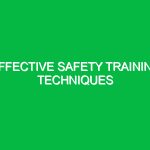When stepping into a new workplace, many employees encounter a whirlwind of information. Among the most crucial aspects is the safety orientation, which lays the groundwork for a secure working environment. Safety orientation for new employees is essential in the Health, Safety, and Environment (HSE) domain, ensuring that newcomers understand their responsibilities, the hazards they may face, and the protocols in place to protect them. Without this foundation, new hires may inadvertently put themselves and others at risk. This article delves into the significance of safety orientation, identifies potential hazards, offers safety precautions, and discusses relevant regulations and standards.
Understanding Safety Orientation for New Employees
Safety orientation for new employees is a structured program designed to familiarize newcomers with the safety culture of an organization. It encompasses training sessions, workshops, and informational resources aimed at instilling a sense of awareness and responsibility regarding health and safety practices. This orientation is not just a formality; it is a critical component of an effective HSE strategy. It ensures that employees are not only aware of the risks but also equipped with the knowledge and skills to mitigate those risks effectively.
The relevance of safety orientation cannot be overstated. Statistics reveal that workplaces with comprehensive safety training programs significantly reduce the incidence of workplace injuries and illnesses. For instance, according to the Occupational Safety and Health Administration (OSHA), effective safety training can lead to a reduction of up to 70% in workplace incidents. Therefore, implementing a robust safety orientation is not merely a legal obligation; it is a strategic investment in the organization’s productivity and employee well-being.
Potential Hazards and Risks in the Workplace
Every workplace harbors its unique set of hazards, and understanding these risks is paramount for new employees. Potential hazards can be categorized into several types:
1. Physical Hazards
Physical hazards include environmental factors that can cause harm. Common examples are slips, trips, and falls, which can occur in any workplace, particularly in areas with wet floors or clutter. Machinery and equipment pose another significant risk, especially when proper safety guards are not in place. In a construction site, for instance, an employee may face dangers from heavy machinery or falling objects. According to a case study conducted by the National Safety Council, falls are the leading cause of workplace injuries, underscoring the need for vigilant safety measures.
2. Chemical Hazards
Chemical hazards arise from exposure to harmful substances. Industries such as manufacturing, healthcare, and laboratories often deal with chemicals that can be toxic, corrosive, or reactive. Employees must be trained to recognize chemical labels, understand Material Safety Data Sheets (MSDS), and use personal protective equipment (PPE) effectively. An incident at a manufacturing plant highlighted this need when an employee suffered burns due to improper handling of a corrosive substance. This situation could have been avoided with adequate safety training.
3. Biological Hazards
Biological hazards are present in environments where employees may be exposed to bacteria, viruses, or other pathogens. Healthcare workers, for example, face the risk of exposure to infectious diseases. Understanding the importance of hygiene practices, vaccination, and proper use of PPE is vital in minimizing these risks. An outbreak of a viral infection in a healthcare facility showcased the consequences of inadequate training in infection control protocols.
4. Ergonomic Hazards
Ergonomic hazards arise from poorly designed workspaces or tasks that can lead to musculoskeletal injuries. Repetitive movements, awkward postures, and excessive force can contribute to chronic pain and long-term health issues. For instance, office workers who spend long hours at their desks without proper ergonomic assessments may develop back or wrist problems. Companies that prioritize ergonomic assessments often see improved employee satisfaction and productivity.
Safety Precautions and Best Practices
With an understanding of potential hazards, new employees need to know how to protect themselves and their coworkers effectively. Here are some critical safety precautions and best practices:
1. Familiarize with Safety Protocols
During the safety orientation, employees should be introduced to the organization’s safety protocols. This includes understanding emergency procedures, evacuation routes, and the location of first aid kits and safety equipment. Regular drills and refreshers can enhance retention and preparedness. For example, a manufacturing company that conducts monthly fire drills ensures that employees are not only aware of the escape routes but also remain calm and collected in an emergency.
2. Use Personal Protective Equipment (PPE)
PPE is a vital line of defense against various workplace hazards. Employees must be trained on the proper use and maintenance of PPE, such as helmets, gloves, goggles, and respirators. Real-life cases have shown that failure to wear appropriate PPE can lead to severe injuries. For instance, construction workers who neglect to wear hard hats risk serious head injuries from falling objects. Encouraging a culture where wearing PPE is a norm can significantly reduce injury rates.
3. Report Hazards Immediately
New hires should understand the importance of reporting hazards and unsafe conditions immediately. Establishing a straightforward reporting process fosters an environment of safety and accountability. For example, an employee who notices a leak in a storage area should feel empowered to report it promptly, preventing potential accidents. Organizations that encourage open communication about safety concerns often experience fewer incidents.
4. Engage in Continuous Learning
Safety orientation should not be a one-time event. Continuous learning is essential in keeping employees updated on new safety practices, equipment, and regulations. Regular training sessions and workshops can reinforce safety knowledge and promote a culture of safety. Consider a scenario where a new safety regulation is introduced; employees who regularly participate in safety training are more likely to adapt quickly to these changes.
Regulations and Standards Governing Safety Orientation
Various regulations and standards govern safety orientation for new employees, ensuring that organizations adhere to minimum safety requirements. In the United States, OSHA sets forth guidelines that employers must follow to protect their workers. OSHA mandates that employers provide training to recognize and avoid unsafe conditions, which directly relates to the orientation process.
Additionally, industry-specific standards may apply. For example, the National Fire Protection Association (NFPA) outlines fire safety training requirements, while the American National Standards Institute (ANSI) provides guidelines for PPE use. Organizations must stay informed about these regulations and incorporate them into their safety orientation programs to ensure compliance and protect their workforce.
Conclusion
Safety orientation for new employees is a critical component of workplace safety in the HSE domain. By understanding potential hazards, implementing safety precautions, and adhering to regulations, organizations can create a safer work environment for all employees. The stories of past incidents serve as reminders of the importance of thorough training and continuous safety awareness. Investing in safety orientation is not just about compliance; it’s about fostering a culture of safety, accountability, and well-being. Ultimately, a well-informed workforce is a key asset to any organization, leading to increased productivity, reduced incidents, and a healthier workplace.


